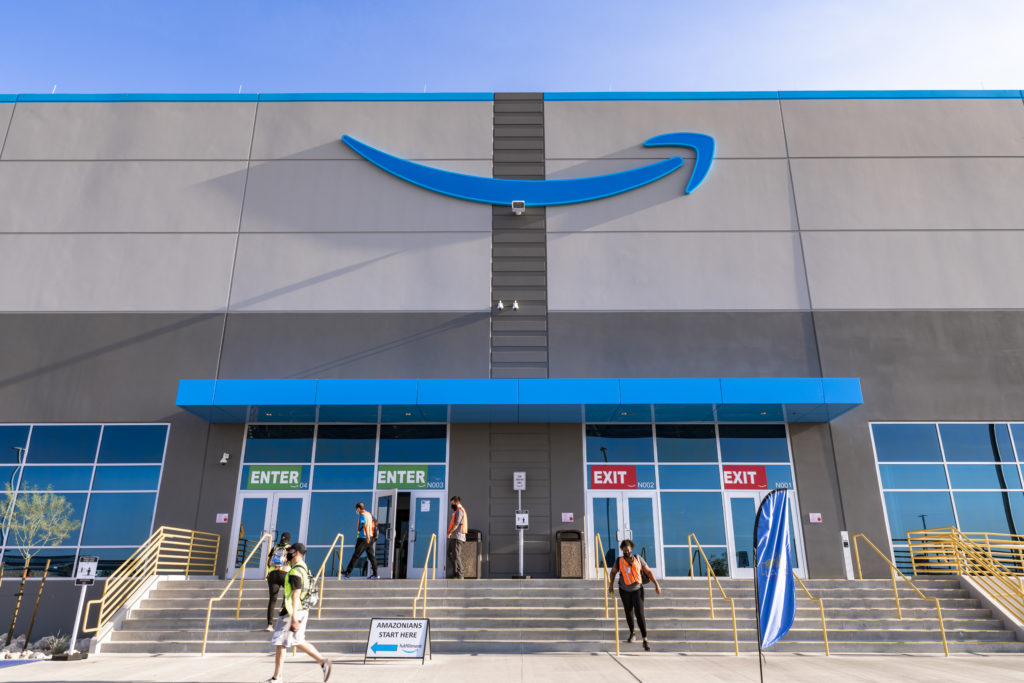Walmart WFS vs. Amazon FBA: Comparing the pros and cons of each
Our previous post offered an overview of Walmart Fulfillment Service, the new 3rd-party logistics program for ecommerce sellers.
It’s no secret that the self-proclaimed world’s largest company has launched in direct competition to Amazon’s Fulfilled by Amazon (FBA) service. Feel free to check out our posts on 3PL services or Amazon FBA to brush up.
This post will explore the specific features and benefits offered by both WFS and Amazon FBA.
Our goal is to help you understand which service is suitable for your fulfillment needs — or if you even need to choose just one.
Digging into the financials
Before we get into the nitty-gritty, let’s take a wider look at both Amazon and Walmart as holistic businesses. Doing so can help us better understand their strengths as well as their future trajectories.
Amazon business overview
It should come as no surprise that Amazon is still the number one ecommerce business in the world. 40% of all sales done on the internet happen on Amazon.com.
Even when COVID-19 disrupted global supply chains, Amazon still saw a 25% boost in their online sales (their fastest recorded growth in over six quarters).
Amazon’s durability is a force to be reckoned with. They’ve got a competitive moat that not even a global pandemic can fully disrupt. Their total quarterly revenue in 2Q of 2023 was $94 billion.
Download the State of Commerce Ops report
Curious what customers want most from online shopping experiences in 2024? Wondering what issues your fellow online sellers are losing sleep over? We asked them.

Walmart business overview
Walmart also unexpectedly benefited from the events of 2020. They were already trending to surpass eBay as the second-largest ecommerce retailer in the United States.
On top of that, their ecommerce sales in 2023 surpassed the $80 billion mark. Walmart’s competitive advantage is undoubtedly its dominant brick-and-mortar infrastructure. They have more than 5,000 stores in the United States. These facilities also double as fulfillment centers for the Walmart Fulfillment Service.
If you thought Amazon’s earnings were impressive, Walmart edged them out by a healthy margin with reported earnings of $524 billion in 2020.
Here are some more relevant metrics on the customers that use Amazon FBA and WFS.

Amazon FBA and Walmart fulfillment services pros and cons
Now let’s zoom in on the specific offerings of Amazon and Walmart in the 3PL space. Here are some at-a-glance advantages and disadvantages of both WFS and Amazon FBA.
Walmart fulfillment service advantages
Less competition
Vendors on Amazon must compete with 3 million fellow sellers for the attention of users. On the other hand, Walmart only has about 30,000 sellers — that’s a 99% decrease. The result is a much more favorable buyer to seller ratio and a higher chance of scoring a spot in the coveted Buy Box.
Easy two-day shipping
Over the past 60 years, Walmart has tirelessly labored to build out one of the most impressive infrastructures in history. 90% of Americans are no more than 15 miles away from a Walmart store.
And remember — the same fulfillment centers that service these stores service WFS sellers. Fast, two-day shipping is a cinch for Walmart.
Straightforward fee structure
Walmart wants to keep things simple. Their fee structure is fixed and easy to understand. This makes it easy for business owners to calculate future ROI before they make the jump to sign up to WFS.
Simple returns
Walmart’s infrastructure makes for a seamless return process. WFS customers can drop off their returns at the nearest FedEx or UPS store (much like Amazon). But if that’s not an option, most items are eligible for return at any Walmart location.
International expansion
Historically, Walmart has preferred to pour its resources into its US-based infrastructure. However, just in 2023, WFS has begun supporting some international sellers. While these are often subject to more scrutiny, it may signify Walmart’s plans to expand into a global marketplace.
Walmart fulfillment service downsides
Not beginner-friendly
If you’re new to ecommerce, you may find selling on WFS overwhelming. Unlike Amazon, Walmart will not allow sole proprietors or LLCs without a unique business Tax ID to sell on the platform.
Further, you must submit an EIN Verification Letter to verify your business address and an established SKU catalog (plus a way to upload those SKUs).
Smaller user base
A smaller user base can be both a pro and a con. While less competition helps you stand out, it can also mean greater difficulty achieving sustainable sales numbers.
Less reputable than Amazon
The thought “I need to buy something online” reflexively leads us to pull out our phones and open the Amazon app. It’s become synonymous with ecommerce.
Walmart on the other hand doesn’t quite have that reputation. In fact, if you would’ve told me two years ago that Walmart was attempting to compete with Amazon in ecommerce, I would’ve scoffed.
Walmart’s stakeholders are working hard to change that reputation. However, it may take some more time to reach that critical mass of customer trust that Amazon has earned.
Intense onboarding process
While the onboarding process for Amazon is pretty plug-and-play, Walmart is a bit more strict. As we mentioned before, sellers will need to prove their business address as well as provide their EIN (SSN will not suffice).
If they don’t have these credentials, they’ll need to register their business with the state and set up their tax structure (which may require accounting help).
These best practices are helpful to do anyway, but for new entrepreneurs or ecommerce sellers, the process may be longer than expected.
Amazon FBA advantages
Multichannel support
Amazon can fulfill orders both within the Amazon FBA platform and through other channels. This flexibility gives business owners the option to have a hybrid 3PL/local fulfillment strategy.
Strong reputation
As mentioned above, Amazon is synonymous with ecommerce. People don’t worry about security, customer support, shipping timelines, or anything else when buying on Amazon. It’s proven itself time and time again as the leader in ecommerce. When you sell on their platform, that trust is transferred to your brand.
More fulfillment options
Amazon FBA sellers can take advantage of Amazon’s recurring shipment programs like Subscribe & Save and Amazon Small & Light.
Amazon Prime eligibility
Brands using Amazon’s fulfillment service may be included in Amazon Prime deals (prominently featured on Amazon’s annual “Prime Day”). These deals can expose previously untapped audiences to your products.
International selling
While Walmart is relatively new to the international fulfillment game, Amazon’s been at it for a while.
Amazon FBA disadvantages
Recurring monthly fees for sellers
If Amazon FBA sellers go with the Professional plan, they’ll have to fork over $39.99 per month in addition to all other fulfillment and storage fees. Walmart, on the other hand, has no monthly fees and exclusively charges by the product sold.
The selling fee structure is not very straightforward
We’ll explore the specifics of selling fees in the next section, but Amazon’s fee structure is tough to keep straight.
I’m a math nerd, and I still find myself scratching my head at all the variables of Amazon’s pricing structure. They even offer a calculator to help businesses figure out their profits because their fees are so complex.
Intense competition
Amazon’s competition is fierce, there’s no doubt about it. Trying to get in that Buy Box — the default vendor that Amazon serves up on a product page — is no easy task. And if you’re not in the Buy Box, most customers wouldn’t even know how to change sellers to purchase from you.
This makes it especially tough to stand out, especially when you’re competing with other vendors selling the same (or similar) products.
Fulfillment fees can fluctuate a lot
It’s normal to charge more in the busy season, but Amazon’s prices shoot way up in Q4. They also jump substantially when brands want to store oversized or heavy products. These costs may not be sustainable for some businesses.
Differences between Amazon FBA and WFS
Let’s look at some relevant categories in the 3PL space and how Amazon and Walmart differ (or align) in their offerings.
Subscription fees
Prospective Amazon FBA sellers must choose either the individual or professional selling plan. While the individual plan has no monthly fee, sellers can’t run PPC ads or compete for the Buy Box.
Unless you’re the creator, manufacturer, and sole vendor of your product, competing for the Buy Box is an absolute must. This makes the individual plan a non-starter for many ecommerce businesses.
The professional plan comes with a $39.99 monthly fee. While it’s not a bad deal considering the benefits offered to sellers, Walmart Fulfillment Services does not charge sellers a monthly subscription fee at all.
Selling fees
Selling fees for Amazon FBA and WFS fall into three categories:
- Referral fees
- Storage fees
- Fulfillment fees
Amazon and Walmart charge referral fees on a category-by-category basis. For example, Walmart charges a 6% referral fee for items sold in the Personal Computers category and a 15% referral fee for items sold in the Music category.
Sellers pay storage fees to compensate 3PL vendors for storing their products. If a product takes up more space, sellers pay a higher storage fee.
Lastly, fulfillment fees cover the cost of the 3PL warehouse team actually picking, packing, and shipping their orders. These fees fluctuate based on product weight.
Referral fees
While Walmart’s referral fees are between 6% and 20%, Amazon’s fees can get up to 45% in certain categories.
However, some products — such as specific apparel pieces and home decor — cannot be sold on WFS. It’s a trade-off that businesses must weigh on a case-by-case basis.
Amazon’s FBA fee structure can get pretty complex. Rather than deducing your ROI on a chart, it’s better to use Amazon’s proprietary revenue calculator to determine your profits.
Fulfillment fees
Amazon has a weight tier list that determines their fulfillment fees. On the other hand, Walmart considers the total dimensional weight of a product. The difference is quite subtle.
Both companies keep these fee structures behind the seller signup portal. But thanks to this handy data acquired by Helium10, we can see the pricing in action in the following table:
| Example package | Unit Weight (before packaging) | Unit Dimensions | WFS Fulfillment Fees | Amazon FBA Fulfillment Fees |
| Example #1 | 6 pounds | 12 x 10 x 10 inches | $7.75 | $11.30 |
| Example #2 | 2.75 pounds | 5 x 5 x 5 inches | $5.45 | $5.42 |
| Example #3 | 20 pounds | 12 x 10 x 12 inches | $16.40 | $15.51 |
You probably noticed the big price disparity in Example #1. That’s because Amazon regards this package as an “oversize item” due to the large difference in size and weight and how they structure their weight tier pricing.
Storage fees
Walmart and Amazon FBA storage fees are usually pretty neck-and-neck — except in Q4. In the holiday season, Amazon’s storage fees shoot way up.
But here’s where things get even trickier. If you store your product in Q4 for longer than 30 days, the fees are higher with WFS.
So you have to ask yourself — will I store my product with a 3PL during the holiday months for less than 30 days? If so, Walmart is the best option. If not, Amazon is better.
Again, don’t bother trying to do all this in your head with Amazon. Use their calculator to figure out your ROI.
As far as Walmart goes, their storage fees are as follows:
- January through September: $0.75/cubic foot per month
- October, November, December (holiday season): $0.75/cubic foot per month for items stored 30 days or less and an additional $1.50 per cubic foot for items stored longer than 30 days
- Products that WFS stores for more than 12 months will incur a $7.50/cubic foot per month storage fee
It’s also worth mentioning that while Amazon can fulfill packages up to 150 pounds and 108 x 165 x 165 inches in size, Walmart caps their package weight at 30 pounds and 25 x 20 14 inches.
This may immediately disqualify your business depending on what you sell.
Logistics services
Both Amazon FBA and Walmart Fulfillment Service provide top-tier services to their clients. When it comes to the excellence of their deliverables, you really can’t go wrong with either.
Both WFS and Amazon FBA have strict quality control processes to avoid mis-ships, stock-outs, and damaged shipments. As mentioned throughout this post, their shipping infrastructures are unparalleled in the business world.
These services include:
- Receiving and storing product
- Picking, packing, and processing product
- Dealing with customer service inquiries and returns
- Accepting liability for lost or damaged products
Seller requirements
Here are the seller requirements for both Walmart Fulfillment Services and Amazon FBA, taken straight from their respective sites:
Walmart Fulfillment Services requirements:
- US Business Tax ID (SSN not accepted)
- W9 or W8 and EIN Verification Letter from the Department of Treasury that verifies your US business address or place of physical operations
- Address or place of physical operations
- US Business address
- Planned integration method for your product catalog (bulk upload, API, solution provider)
- Primary product categories, catalog size, and related information (e.g. total SKUs you will be selling on Walmart.com initially with verified UPC information and used vs. refurbished etc.)
Amazon FBA requirements:
- Bank account number and bank routing number
- Chargeable credit card
- Government-issued national ID
- Tax information (you may use your SSN here)
- Phone number
While Amazon FBA doesn’t require a US-based business address, you must be a resident in one of these countries to sell on their platform.
Expert support
Walmart offers personalized support and the expertise of a WFS fulfillment expert to all WFS sellers. They’ll not only help sellers resolve issues, but offer feedback on how to grow and best utilize the WFS platform.
The Amazon equivalent of this dedicated support will cost an extra $1,600/month in addition to a higher per-product fee.
Listing optimization
Both Amazon FBA and WFS allow sellers to customize and optimize their listing. Many of the same principles that make a good landing page or sales page apply to Amazon or WFS listings.
This includes:
- Performing keyword research and including those keywords in your titles, subtitles, and descriptions
- Featuring professional photos of your product in action and up close
- Highlighting positive reviews or other social proof
- Including a robust FAQs section to overcome buying objections
Both services facilitate these optimizations, but Walmart takes it a step further. WFS sellers have access to a Listing Quality Dashboard which provides metrics on listing performance.
Within the Walmart Seller Center, vendors can also access Walmart’s “Growth Opportunities” dashboard. This tool shows popular trends on the platform and how your products may intersect with customer demand.
Reporting
Both Amazon FBA and WFS have robust analytics for on-hand inventory, sales, and revenue. Sellers can see how their listings perform, read customer reviews, and identify their most popular products from easy-to-use dashboards.
Amazon and Walmart can also integrate with Inventory Management Software (IMS) platforms like SkuVault. We’ll talk more about that in our next post all about developing a holistic 3PL inventory strategy.
Which one is right for my business?
Based on the information we’ve covered in this post, you should have a pretty good idea of which service is right for you. Let’s summarize some of our insights.
Remember that Amazon favors newbie entrepreneurs and ecommerce sellers with its low barrier to entry, but has much steeper competition.
Walmart is great for established businesses and has a much more favorable buyer to seller ratio. That said, they still have a lot of PR to do to earn a reputation as strong as Amazon’s.
Amazon’s storage fees are substantial in the holiday months. However, Walmart’s fees are higher if you store products with them for longer than 30 days.
Amazon charges a monthly fee for just the ability to compete for the Buy Box, whereas Walmart has no monthly fees, and earning the Buy Box (or Walmart’s equivalent) is much more feasible.
Can I sell on both Amazon FBA and Walmart fulfillment service?
If you don’t want to choose between Amazon and Walmart — well, you don’t have to! The good news is that established businesses who meet all the requirements of both services can freely sell on both services.
Diversification — establishing a multichannel strategy — is something we highly recommend for ecommerce businesses. Your customers are everywhere, and success means getting your solution in front of them at every turn.
In our next post, we’ll talk about how you can integrate WFS with your IMS platform of choice. Stacking 3PL services with an automated inventory management platform is a game-changing strategy that’s essential for boosting your revenue and growing your business.
